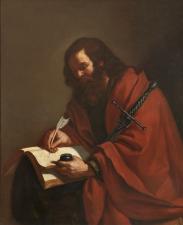St. Paul
The subject
St. Paul of Tarsus has been one of the most widely used religious subjects in artistic imagery over time due to his strong emotional influence and the moral message he conveyed to the faithful. In figurative iconography he is primarily portrayed at the moment of his conversion (the most famous versions include those by Caravaggio in Saint Mary of the People in Rome and by Michelangelo in the Vatican frescoes of the Pauline Chapel). Here instead, the Saint is depicted as a solemn apostle with a long, thick beard that enhances his wise and charismatic appearance and is accompanied by the traditional iconographic elements: the sword and book. The first is leaned against his side and has a double meaning, representing his initial persecution of Christianity while also being the tool with which he suffered martyrdom by beheading; the book in which he is writing represents the apostolic ‘letters’ which were included in the Sacred Scriptures and became famous doctrines.
The painting
This is an original work by Guercino, dating from around 1644. Once again the artist’s account book identified it. The “Account Book” includes notes on the delivery of two paintings one of which is a “St. Paul” painted in 1644 for Mr. Abbate Panici. Carlo Volpe found that date recorded on the back of the painting (written communication on 15 October 1972). In addition, Malvasia recorded the painting in Felsina Pittrice naming the same painter and year of creation. The figure sits in a clear, diffused light that however does not give into shadows in the background, a pleasant reminiscence of Caravaggio, recalling the St. Paul of Certosa di Pavia completed by Guercino three years prior. This time span sufficiently explains the master’s subtle variations, not simply copying the older works but reusing their designs. The work was displayed as the original at the individual exhibition on Guercino held in Bologna in 1968.







